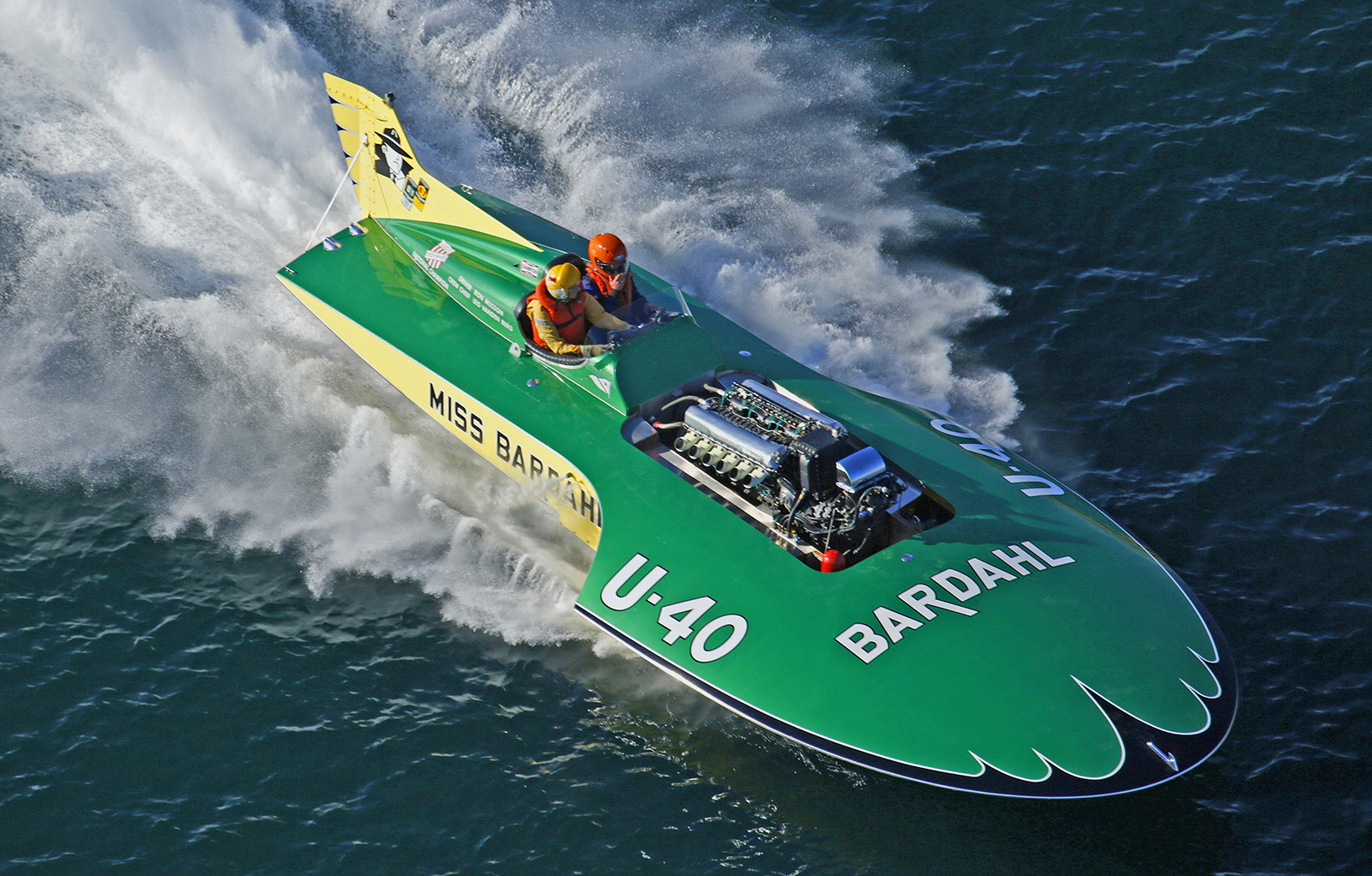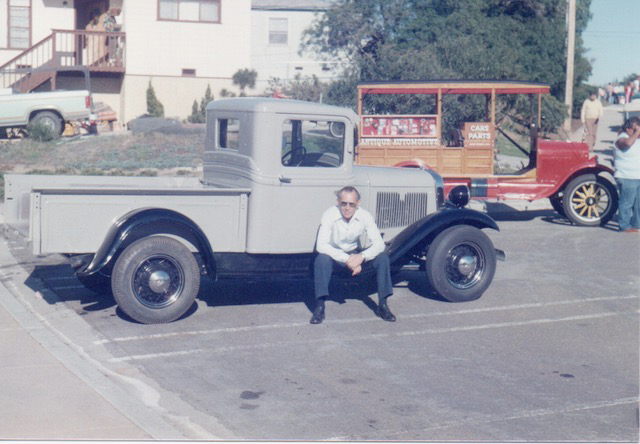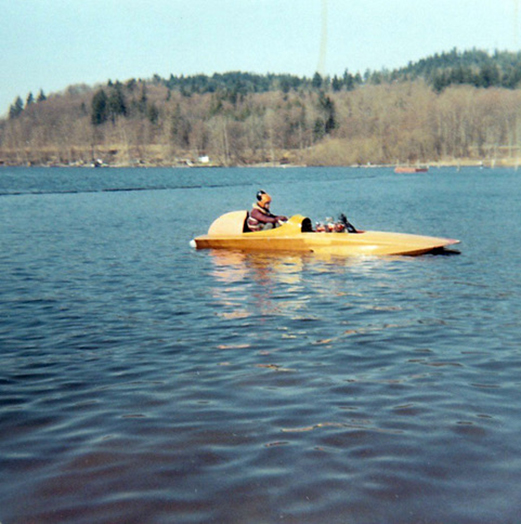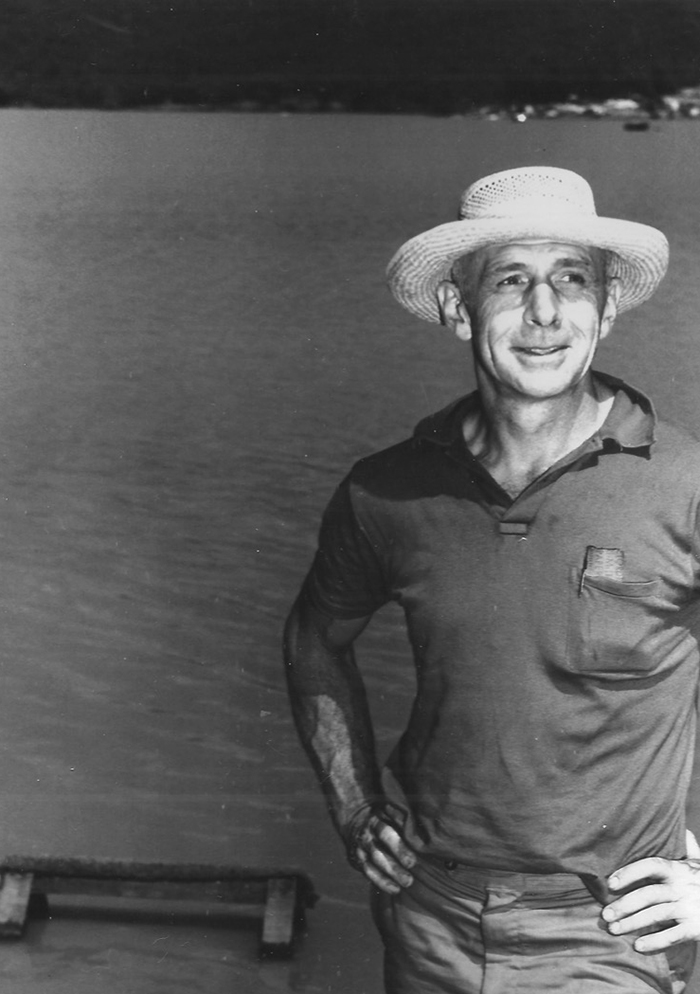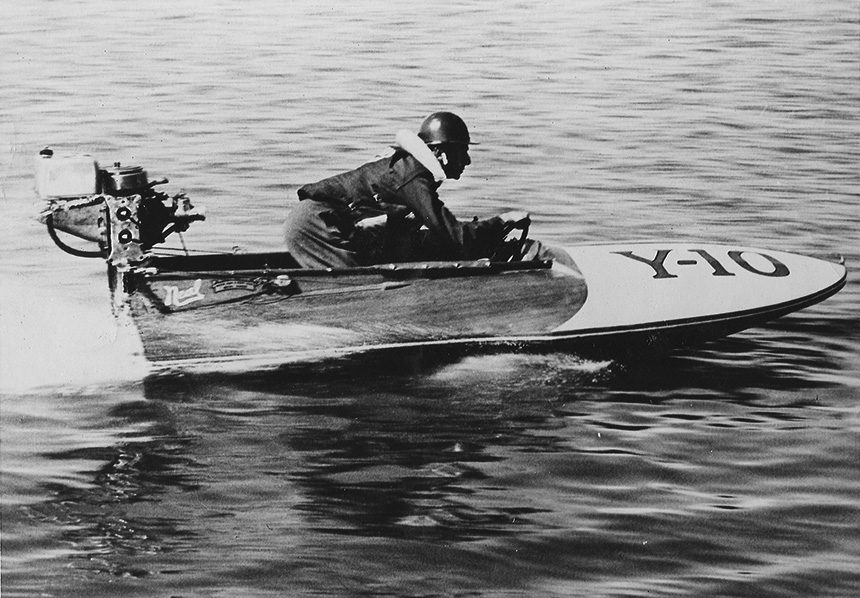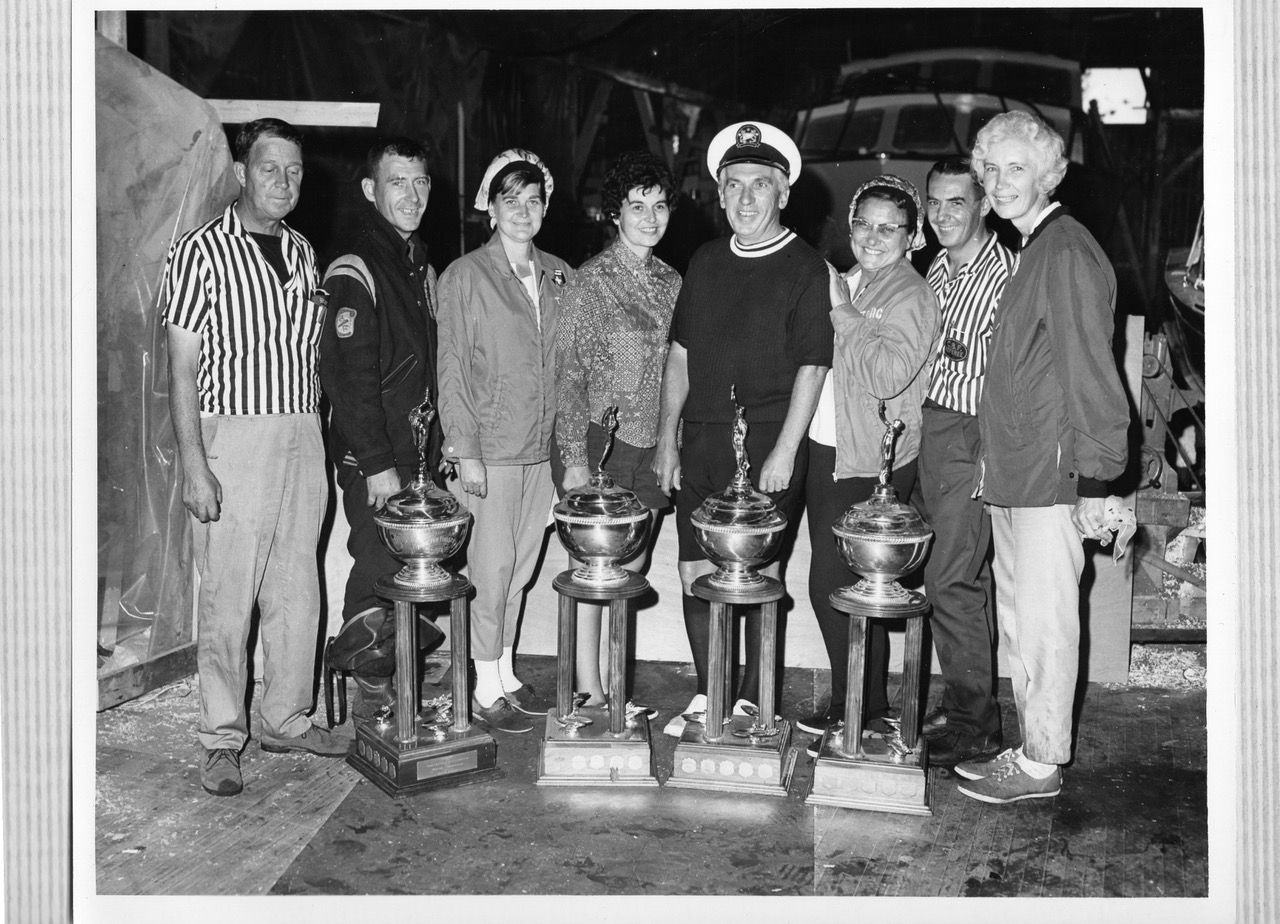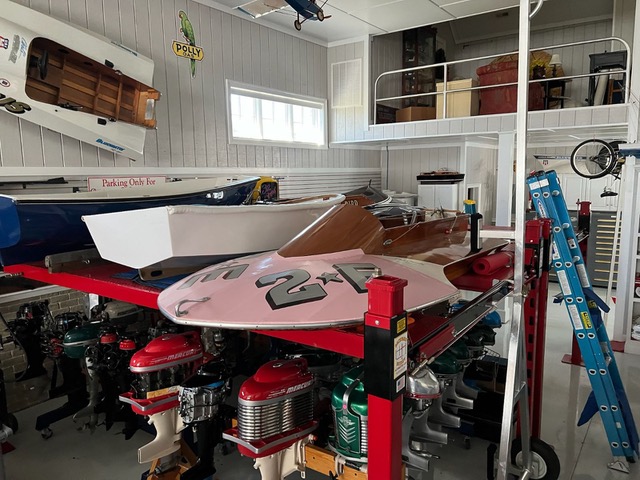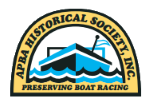Remembering Billy Schumacher
September 26, 2023 - 6:30pm
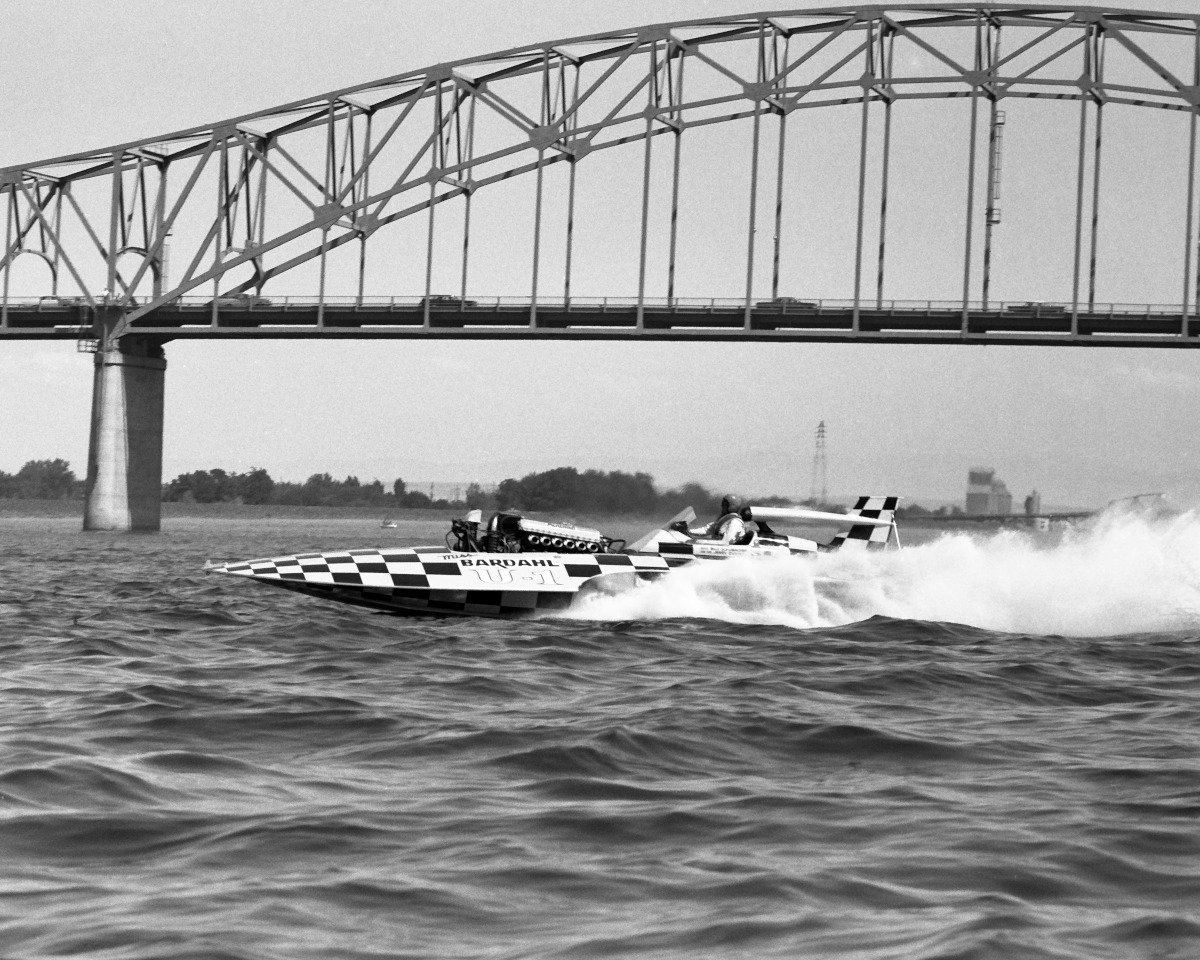
Billy Schumacher enjoyed his most successful seasons in Unlimited hydroplanes in 1967 and 1968, driving Miss Bardahl. Bob Carver photo
By Craig Fjarlie
Billy Schumacher was one of the top drivers in boat racing history. He won the APBA Gold Cup twice as a driver and again as an owner. He was a champion in outboards, inboards, tunnel outboards, and Unlimited hydroplanes. He passed away at his home in Seattle on August 31, 2023, at age 80. The following memorial is based on an interview with Schumacher that was conducted on May 29, 2019.
One of the first things to know about Billy is that he pronounced his last name “Shoemaker.” He was born in Seattle in October, 1942. His father, a baker by trade, was an avid water skier. “It all started when I was putzin’ around with my father and his group’s water ski boats and canoes and anything else they had that would float. I was interested in it,” he remembered. “When he asked me if I wanted a race boat, I agreed. He bought one that could be converted to a larger class also.” Billy’s father bought a runabout and gave it to him as a Christmas present. Before Billy was old enough to race, his father ran the boat in the Sammamish Slough race as a B Runabout. “He ran it up the Slough and didn’t make a corner. Went up on the bank and hit a tree. He didn’t get hurt, but the boat did.” The senior Schumacher decided to stick with water skiing and let Billy do the racing. “I was actually really happy with that,” he said.
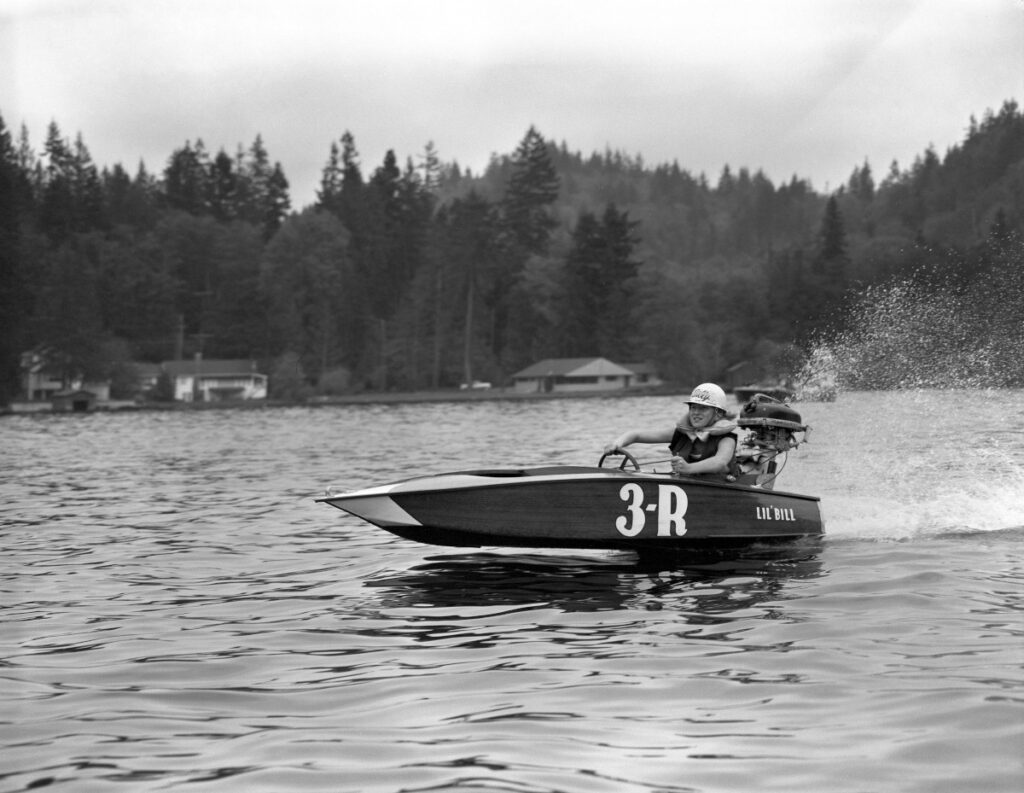
Schumacher in his J Runabout. Bob Carver photo
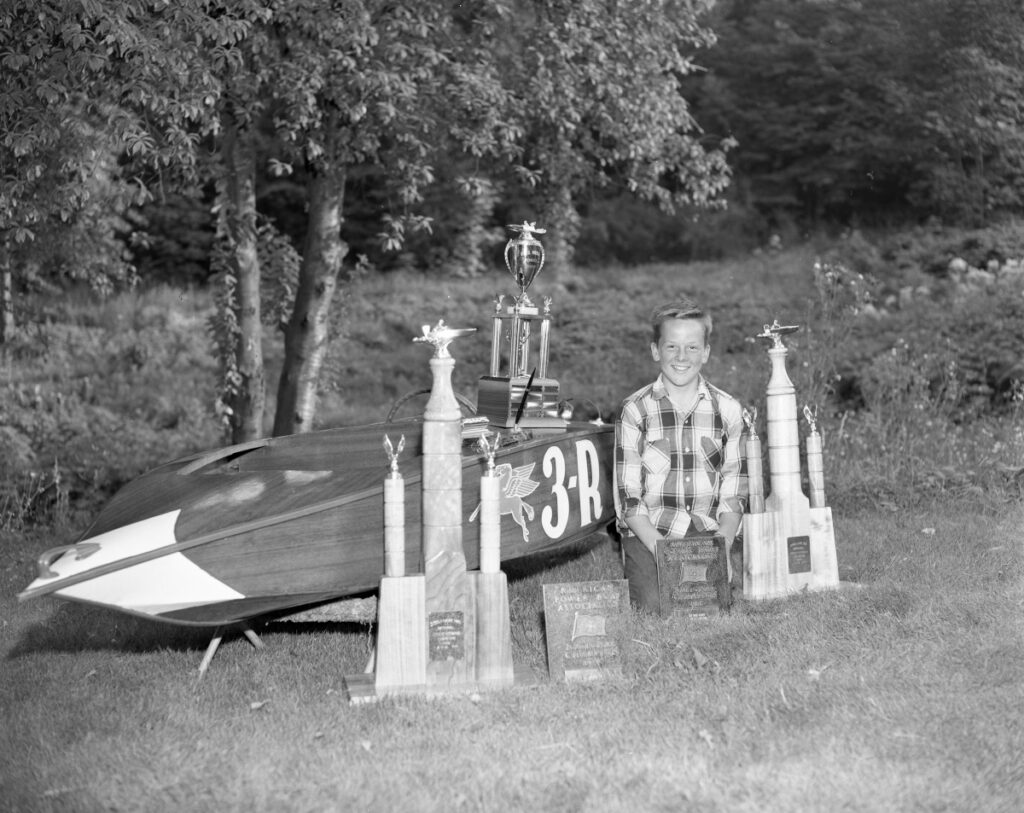
Young Billy with some of his outboard trophies. Bob Carver photo
The damaged boat was repaired, but Schumacher’s father bought a new boat that was being built by Ed Karelsen. “It had a warp in the bottom, which wasn’t normal,” Schumacher recalled. “It turned out to be a concave bottom and when it got up to a higher speed, it rode on a ‘U’ shape. It had very little drag and the boat was fast. I won many races with it in JU, and then I ran AU with it. I’d win almost every time.”
Schumacher sought driving advice from his father’s friend, Lin Ivey, who also raced outboards. “Lin told me, ‘Start on the inside if you can, because it’s not only the shortest way around, but you can leave the rest of the field behind you.’ I always remembered that. And he said, ‘When you start your race, once you’re committed to the starting line, stay on it. Don’t change your mind halfway there.’ A lot of guys did that. They thought, ‘Oh, I’m early’ and they’d back off. As soon as they did that, you had ‘em. That was good advice.”

Billy Schumacher’s B Stock Hydro. Bob Carver photo
A few years later, Schumacher started driving outboard hydros. “My father bought an A Stock Hydro. It was a Karelsen boat, copied after a Swift,” he said. “Chuck Lyford raced A Hydro. His dad had a Jacobsen built for him. Chuck would win a lot of races because that boat was really fast. He and I would battle constantly.”
In 1956, Schumacher went to the Stock Outboard Nationals at Cambridge, Maryland. One of his rivals was a young Dean Chenoweth. “Dean was the top-notch guy on the East Coast back then.” Schumacher won JU, but finished second to Chenoweth in AU.
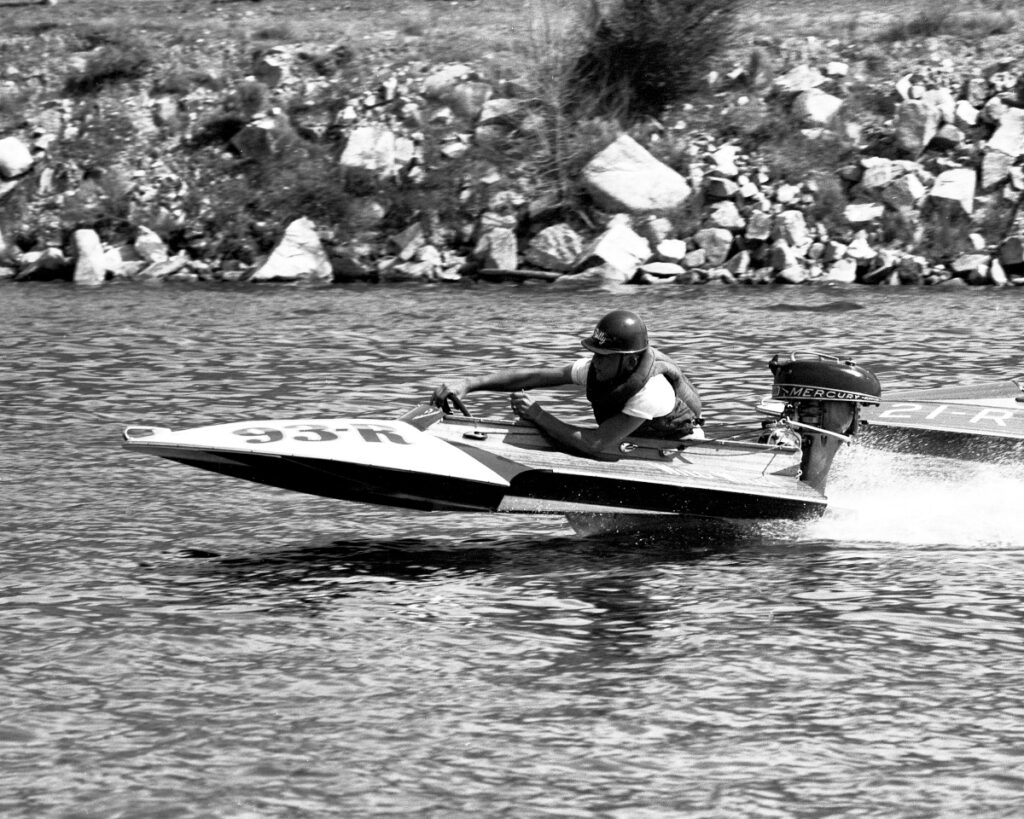
Billy Schumacher in an A Alky Hydro. Bob Carver photo
Schumacher moved into larger outboard classes, including C Stock Hydro and D Stock Hydro. “I wasn’t as thrilled with that,” he admitted. “I wanted a runabout. That was just more fun for me. But I knew if I ever wanted to race limited inboards or even the Unlimiteds – and I thought about it even in those young years – I knew I had to learn how to drive a hydroplane better than anything. I think the runabout taught me more about water and wind and all that. I won so much back in those days people would ask me to drive their boats. One race, in Oregon, I ran 11 different classes. They had a trophy for the driver who had the most points at the end of the race, regardless how many classes you ran. Between all the classes and everything, I won hands down.”
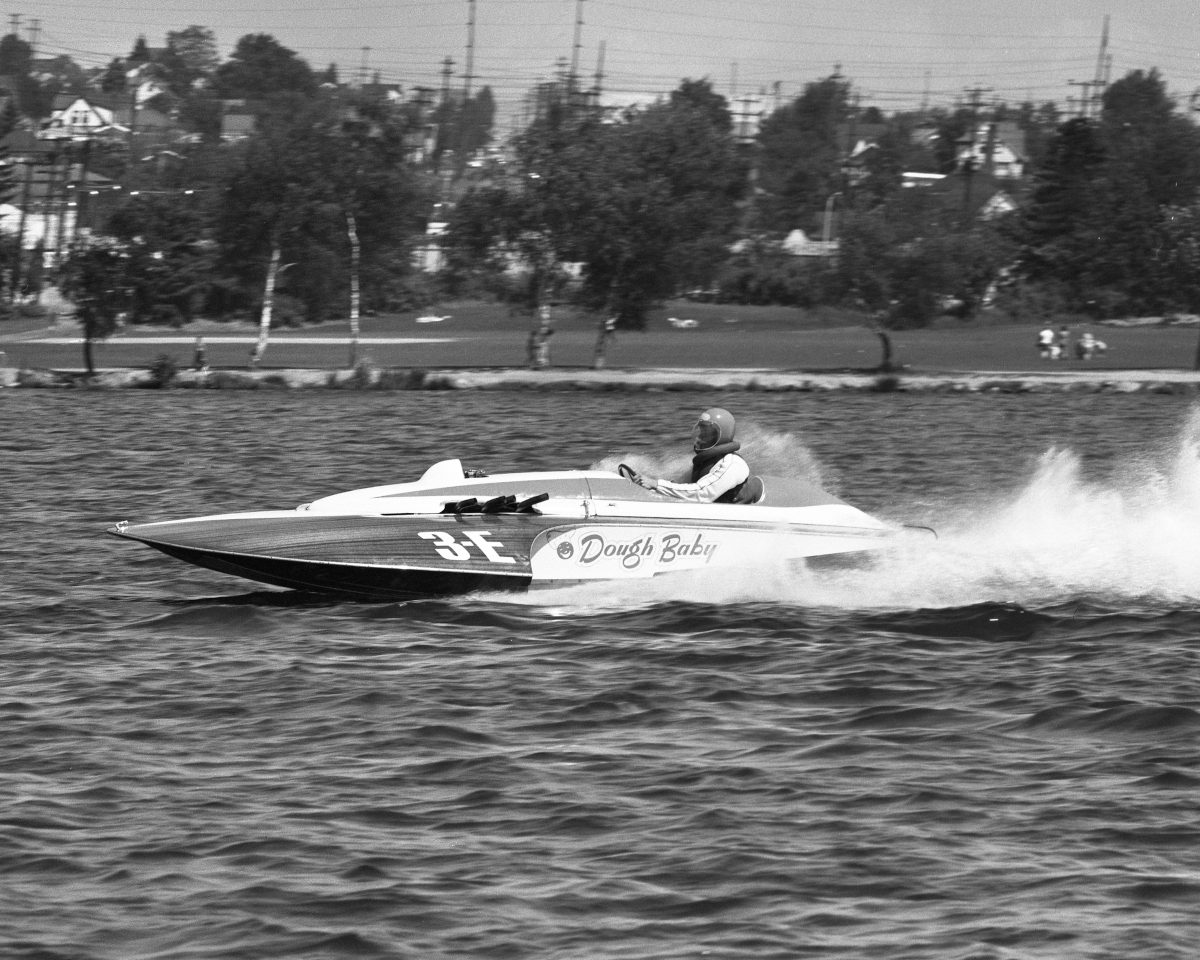
Billy Schumacher in his 280 inboard, Dough Baby. Bob Carver photo
In 1959, Schumacher began driving a 280 inboard that he named Dough Baby. “It was Bill Muncey’s boat. It was called Thrifty Chevalier. He won a lot of races with a 266 in it. When we bought it, my father decided I should run 280 because I was new in the inboard class. Muncey put a stock engine in it and it went fast enough that I was able to win races with it—on the west coast, anyway.”
Schumacher went through a learning curve before he began to feel comfortable in an inboard hydroplane. “The other boats seemed huge; I wasn’t accustomed to seeing a boat that big next to me. I was a little bit afraid of it, quite frankly,” he admitted. “The other guys were a little faster, but not fast enough to catch me, so I would win quite a few times. We raced against Lyford again, and he was pretty fast in his boat. Donnie Benson had another boat he was racing called Calypso, and that was a really fast boat.” Schumacher later had an opportunity to drive a 225 boat, Miss Goodwin. “Doug Whitley owned that,” he remembered.
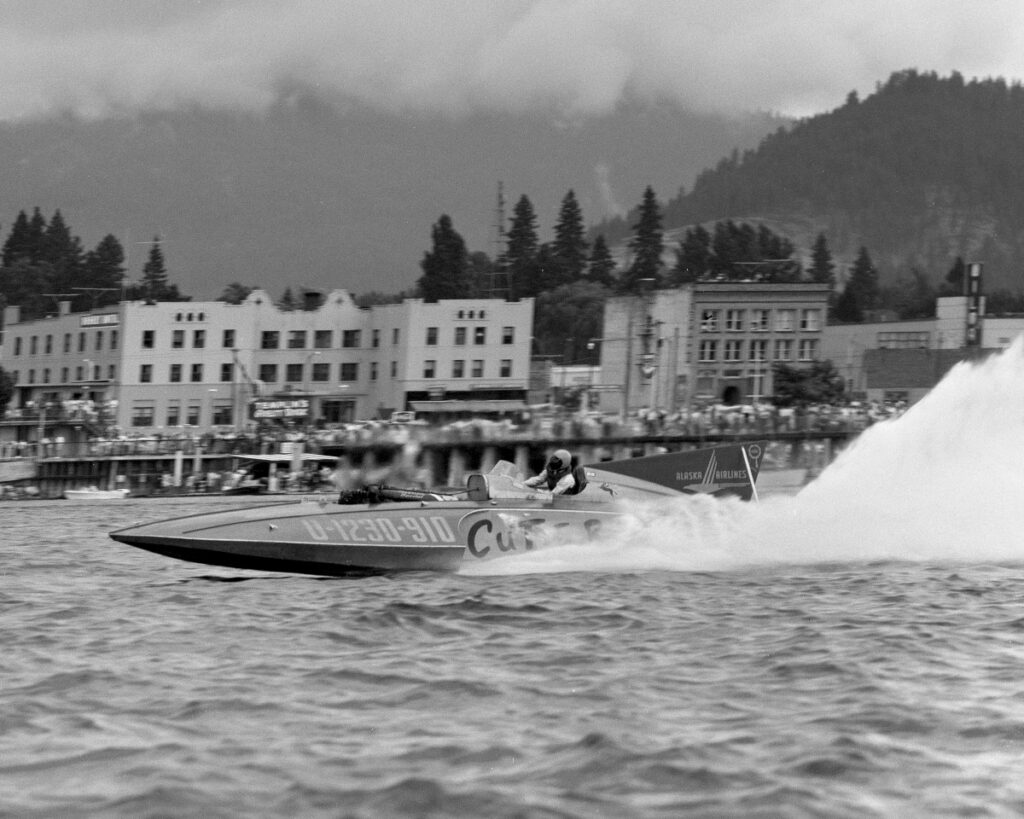
Billy driving Cutie Radio at Coeur d’Alene in 1961. Bob Carver photo
In 1961, Schumacher received an offer to drive a low-budget Unlimited, Cutie Radio, owned by Bob Miller. “He knew about my outboard and limited experience and my accumulation of victories, so he wanted to give me a try.” His first race was the Diamond Cup at Coeur d’Alene, Idaho. “I remember running a lot of laps in that boat, just learning how to qualify. Bill Muncey, because he sold us our 280, was right there to help me with anything I needed, and also to give me advice on what to do and what not to do.” Muncey advised Schumacher to stay out of the way. “I didn’t listen, because no one competitive wants to stay out of the way! I knew that boat wasn’t fast enough to win, but I thought they could safely go around me, which they did. In that particular race, all the other boats either crashed or conked out and we wound up with third place.”
The next Unlimited race was in Seattle. “Dave Johnson asked me to drive his Miss Tool Crib. That’s when I resigned from Cutie Radio. It wasn’t fast enough to win much of anything, but it was faster than Cutie Radio. The gear box kept coming loose. That was a concern, because it was sitting right in front of me. They’d have to tighten it up after every heat that I ran.”
Schumacher made a detour back to outboards for the 1962 Sammamish Slough race. He drove an unlimited outboard in a celebrity race. “It was a runabout that Jack Leek put together,” Schumacher explained. “He was in charge of OMC’s racing division. He heard I was going to go up the Slough with a disc jockey in a runabout that Jacobsen built. He was good friends with Jacobsen, so the two of them got together and Jack brought out a V-4 from the factory for that race. We didn’t get it started as quickly as some of the other guys, so I had to pass them in the Slough. I turned around to look at the disc jockey because he was sitting in the back. His eyes looked like tennis balls—he was frightened to death. I would cut corners people normally wouldn’t, because I knew it was safe to do it. We won that race. I had an advantage with Jack Leek’s motor. It wasn’t fair, but it was an unlimited class, so there you have it.”
Schumacher’s next opportunity to drive an Unlimited hydroplane came at the end of the 1963 season. Bill Schuyler asked him to drive $ Bill at Lake Tahoe. “The water was really rough. I remember the race well, even though I was young. Back in the ‘60s, the water was crystal clear. You could see the bottom 100 feet out. It was such a big lake that you’d get swells that you couldn’t see. I got the best start with the $ Bill and came down toward the first turn. Hit one of those swells. The boat flew out of the water. I don’t know how far I was in the air, but it felt like a long time. I was probably going 160 or better, because Schuyler had a two-stage Allison in it. It was fast enough, when it stayed together, to beat everybody, all the hot shots, but it wouldn’t stay together. It would blow up within a lap. That’s what happened as soon as I hit that wake. When it over-wound while the propeller was in the air, it just blew that thing sky high.”
Schumacher drove for Schuyler through 1964 but never won a race. He returned to inboard racing the following year. “I had the 280 and I think I was driving the 136, JJ & MM, and I drove Lyford’s boat, Challenger, in a few races. I’d listen to the Unlimited races on the radio.” The Miss Bardahl team had a new boat for 1966, a cabover built by Ron Jones. Regular driver Ron Musson wanted Schumacher to test the new boat. “It did have a problem,” he confirmed. “It would get up to 155 or 160 and the boat would cock left. It wouldn’t necessarily turn left, it would cock left. It was kind of a scary experience, but it would drive wonderfully before that happened.” Musson was killed in the boat at the 1966 President’s Cup in Washington, D.C. “That isn’t what caused the accident,” Schumacher emphasized.
Ole Bardahl, owner of the Bardahl team, contemplated retiring from racing following the 1966 accident, but decided to have a new boat for 1967 with Schumacher as driver. Bardahl and Schumacher went to the Unlimited race in Tri-Cities, Washington, in 1966, to analyze the different boats and decide what design was best. “He asked me what kind of boat he should buy,” Schumacher explained. “I told him I didn’t think he should buy one, I thought he should build one. The question was, who should build it?” Schumacher convinced Bardahl to have Ed Karelsen build the new boat.
Bardahl watched as Karelsen built the boat. “Karelsen would be putting a nail or staple into something and Ole would say, ‘No, no, no, no, I want a screw,’” Schumacher said, mimicking Bardahl’s Norwegian accent. “So, that’s the way it was built. It was built well, and it worked out right from the get-go.” Schumacher drove Miss Bardahl to victory in the APBA Gold Cup and the National High Point Championship in both 1967 and’68. The boat had a solid yellow paint scheme the first year, but a yellow and black checkerboard scheme the second year. Bardahl had hired a marketing director who wanted the company’s hydroplane, racing airplane, and Indy car all to have the same checkerboard paint scheme. “I personally didn’t like it,” Schumacher admitted. “As it turned out, it was a really popular color scheme with everyone else. It did show up on the water extremely well. It probably was the most popular Bardahl boat ever. That was a pleasure for me to be able to drive it. In my racing career from beginning to end, the most success I ever had racing was with this Bardahl. It was a fun boat to drive.”
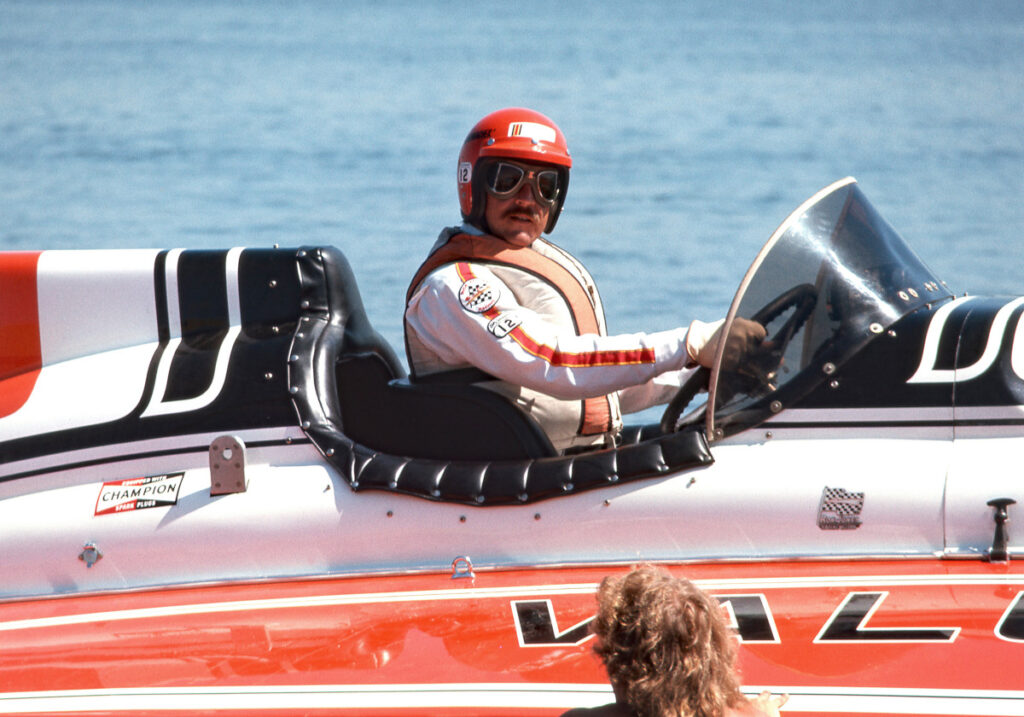
Billy Schumacher in Valu-Mart, in 1974. (Note he was sporting a mustache.) Photo by Randy Hall
Schumacher sat out the 1969 season, but drove Parco O-Ring Miss, a new boat built by Karelsen for Laird Pierce in 1970. The boat was supposed to be a copy of Miss Bardahl, but never lived up to expectations. Schumacher explained, “We didn’t know, but he built it narrower—as much as 12 inches narrower. It wouldn’t get enough air under the boat. There was nothing, absolutely nothing you could do to that boat to make it go fast. It was a handful to drive.”
Schumacher drove Pride of Pay ‘N Pak in 1971, for owner Dave Heerensperger and crew chief Jim Lucero. “With the Bardahl, I had to watch the manifold pressure constantly. Of course, a lot of that was our high-dome pistons.” Lucero had a completely different perspective. “When I got to the Pay ‘N Pak I said, ‘How much manifold pressure should I look for and where should I stop?’ He said, ‘Manifold pressure? I don’t want you to even look at the gauge. Just stare at where you’re going and win the race.’ In my whole career with Pay ‘N Pak and Jim Lucero, I don’t remember breaking an engine. I don’t think we broke one single engine. Totally amazing to me.”
The first race in 1971 was at Miami Marine Stadium, and Schumacher had a close call. He was going into the first turn when the keyway in the rudder system broke. “As soon as I decelerated, it took the pressure off the rudder and it started vibrating violently. The steering wheel got really fat. The next thing I knew I was in the air. I saw the stadium in my eyes and I thought, ‘It’s been a short life.’ That’s the last thing I remember until I woke up in the water, face down. When you decelerate and the keyway is no longer holding the rudder, it moves. The boat stuck on its side. Threw me out and did a complete loop in the air.”
The Pride of Pay ‘N Pak team made several adjustments to the boat before it turned into a winner. Schumacher watched Jim McCormick drive Miss Madison to victory in the APBA Gold Cup on the Ohio River. “I think I could have won that Gold Cup, but he was faster than I expected him to be, and legitimately won the race. He drove the pants off that boat, and it showed.” The Pay ‘N Pak finally hit its stride and won the last three races of the season.
The 1972 season was dominated by Atlas Van Lines, driven by Bill Muncey. Schumacher abruptly resigned from the Pay ‘N Pak at Madison, Indiana, because of course conditions. “The water was horrible at Madison,” he recalled. “The river was dark brown, the buoys were on their sides from the current, and you could see logs coming down. Race on that? I just said, ‘No.’ I got into my motorhome and drove away. I should have gone to Heerensperger or Lucero and said, ‘Look, I’ve had enough of this and I’m not going to do it anymore,’ but I didn’t. I just drove away.”
Schumacher was living in Marina Del Ray, California at the time. Before long, his racing career took a very different turn. “Ron Jones found out I was there. He had built a tunnel boat that people didn’t like driving and asked if I’d test it. Rick Keller owned the boat. He was from Yorba Linda, which wasn’t far from where I was living. When Jones asked me to drive that tunnel boat I did, at Lake Elsinore. I came back and reported to him that it was an extremely tricky boat to drive. It wasn’t one of my favorites. Keller told me, ‘We can get another boat, because I’d like you to drive for me.’ He was going to get another boat after we raced this one.”
Schumacher was going to be the co-driver with Keller at a race in Arizona. “It was a long race. He would drive for an hour or two and then I would, then he would, and so on,” Schumacher explained. “In his first run at it he crashed the boat and broke it. I didn’t have to race it. Keller bought another tunnel boat. It was a Scottie, which was one of the popular boats back then. My first race was at Lake Havasu. I don’t know how many boats were there, but close to one hundred. At the end of the race, I had learned how to drive it well enough that I was gaining on everyone. We wound up third and I was real close to getting second. Jack Leek noticed that, so I wound up driving for him in Paris.”
The marathon in Paris was a major event in the early 1970s. “I drove with John Sanders,” Schumacher recalled. “We shared; he drove an hour and a half, I drove an hour and a half. We won by six laps, which was really quite an accomplishment. I’m still the only guy ever to win it in his first season.”
In spite of his success with tunnel boats, Schumacher was anxious to return to driving Unlimited hydroplanes. He met Jerry Barker, a friend of Rick Keller. “We became friends and he asked me if I was interested in looking at turbine power in Unlimited racing. I said, ‘Sure, I’ll look at that. They’re running out of Rolls-Merlins, they need to do something.’ He said, ‘I have a good friend in Seattle who is interested in maybe doing a turbine hydroplane.’ So, I went to work immediately and did a lot of research on turbines. Came up with the Lycoming turbine that we’re running today. I found a guy in California who did gear boxes. I came up with the gear box some of them are using today. I went to the Unlimited Racing Commission and I got them to agree to let me run a turbine for two years as an experimental deal. Jerry Barker invited me up to Seattle to meet with Jim Clapp, who was involved with the Space Needle and properties all over Seattle. He had the money to do it. We sat down at the Seattle Yacht Club and discussed it. He decided to go forward with me on the turbine. I showed him my plan, told him about the engine that I wanted to use, the gear box I wanted to use. I wanted Ron Jones to build the boat. He had a shop in Costa Mesa. Jim wound up writing me a check for $30,000. I took that check down to Ron Jones, gave it to him, got him to give me a deal, contract with Jim Clapp to build the boat.”
During the initial stages of building the boat, Schumacher received a call from Clapp. “He asked if it would be OK if he brought Chuck Lyford on board to help with the project. I said, ‘Absolutely. Chuck and I are good buddies, it’ll be a big asset, he’s a real smart man.’” Slowly, things began to change under Lyford’s leadership. “Chuck more and more started taking over the project, because he was in Seattle with Jim Clapp. He was communicating with Ron Jones more than I was, which I didn’t know,” Schumacher said. “He came up with a different turbine program, with twin engines rather than mine. He came up with his own gear box program because he had to connect two turbines into it. So, my program had pretty much been changed entirely. The next thing I know he called and told me I’m asking too much to drive the boat. I said, ‘Well, Chuck, did you forget this was my project?’ He said, ‘It was, but it isn’t any more. It’s my project and you’re asking too much to drive the boat. I have a young man up here that has offered to drive it for free.’ I hung up. Never talked to him again for at least a couple of years. That’s the way the U-95 got started.”
In 1974, Schumacher finally had an opportunity to return to driving an Unlimited. Les Rosenberg, who was an executive with Valu-Mart stores, owned a boat that had handling problems. He asked Schumacher to take it for a test drive during qualifying time for the Seattle race. “That was my first time in it. Got back to the pits and I said, ‘Les, the boat has a lot of potential, but the seat is wrong, the foot pedals are wrong, the steering wheel is wrong. Other than that, it’s a good boat.’ He said, ‘What is it going to take to get you to race it?’ I told him the number and a couple other people that knew me from racing vouched for me.” Schumacher replaced Ron Armstrong in the cockpit for the remainder of the season. “We finally got Valu-Mart running really well at the end of the year at San Diego.” Schumacher won the opening race of the 1975 season at Miami Marine Stadium.
Rosenberg’s boat needed new financial backing for 1976, so he and Schumacher met with executives of Olympia Beer and brought them on board as sponsor. Olympia Beer won the final race of the year at San Diego. It was Schumacher’s last race as a driver. He was away from racing for a number of years. “I went to a few races to say hi to friends. It was difficult for me to get in and all that. I finally decided the heck with it, I’m not going to go any more. I didn’t want a whole lot to do with it.”
Decades passed, and Schumacher began thinking about returning to racing. “The bug kind of bit me later; and when Bernie Little died, I started thinking about it a little bit. I had remarried, and made the mistake of taking Jane to Detroit. It was her first race to see in person. One of the heats was already on. We’re walking down the dock at the Detroit Yacht Club and here’s this yellow boat flying through the air, upside down. I said, ‘There’s one of the wrecks, right there.’ She saw that and said, ‘Oh, my God!’ He landed about 20 feet from a cabin cruiser that had about 10 people on the top deck. Had it landed on that it would have been a terrible disaster.”
The yellow boat that flipped was owned by Bill Wurster. He was ready to retire from racing and when the 2005 season was over, Billy and Jane Schumacher bought the boat. “I wound up getting a sponsor through some friends—Bill Cahill’s Beacon Plumbing.” The boat went east to the 2006 race in Madison, Indiana. Jean Theoret was the driver. The crew started the boat on the trailer and it caught on fire. “They hooked up a line wrong and it was spitting fuel into the exhaust pipe,” Schumacher explained. “It was late at night so it was really pretty, but I was afraid the boat was going to burn down.” The fire was quickly put out and the boat survived with only some blistered paint. Then, during the race, the engine blew. “It came into the pits broken up a bit and underwater. People were saying to me, ‘Welcome to Unlimited racing.’ I thought, ‘Oh, jeez, this is the way it’s going to go?’”
![]()
Beacon Plumbing, owned by Billy and Jane Schumacher and driven by Jean Theoret, in 2006. Gleason Racing Photography
The APBA Gold Cup was in Detroit the following weekend. The boat was repaired from the problems in Madison. “I called Bill Cahill and said, ‘We don’t have a sponsor for Detroit. What do you think if I just put Beacon Plumbing on it?’ He said, ‘I think I’ll come back and watch the race if you do that.’ Theoret had enough points to get into the final, just barely. I saw that he was pretty fast and I thought, if Theoret can get a good start, we can win this race. And that’s what he did. Cahill’s sitting there watching Beacon Plumbing win the Gold Cup.” The boat also won in Seattle and San Diego that year. In 2008, it won in Evansville, Indiana.
The boat had a serious flip in 2009 at Madison, and Theoret was badly injured. In Detroit that year, the boat carried the name Miss DYC. J.W. Myers drove while Theoret recovered. Theoret stepped aside for the 2010 season and Myers again drove for Schumacher. At Detroit, the boat was named Peters and May. As Myers was going through the sharp Roostertail turn, the skid fin came off and he hit the seawall with the right side of the boat. “We could have fixed it, but we already had a new boat started. The decision was made to use the old boat for parts and finish building the new one,” Schumacher explained.
The new boat was ready for the 2011 season. J. Michael Kelly was the driver of Degree Men. Schumacher had nothing but praise for Kelly. “I can’t speak highly enough of J. Michael as a driver. He makes fewer mistakes than anybody I’ve ever seen. He’s an attentive guy who wants to win. He’s a very talented race boat driver.”
Schumacher’s last season as an owner was in 2014. The boat only participated in the races at Tri-Cities and Seattle, with Dave Villwock in the cockpit. Fuel restrictions were in place and at both events the boat was called for violations, which prevented Villwock from winning.
Schumacher never drove the turbine-powered boats he owned. “I’ve been in the cockpit, but I’ve never even started a turbine. I’m too old now, but I don’t want to get interested in it. You know, I always want to go as fast as I think I can, safely. Even when I was first involved, I didn’t want to do it, because I was afraid I might like it! As a driver, you always think you can do it better than the next guy. If you don’t think that, you shouldn’t be doing it.”
Billy Schumacher was one of hydroplane racing’s best drivers. In the Unlimited class, he won 17 races and captured the season High Point title three times. He was a crowd favorite during the years he was an active driver, and a role model for future racers. In 2016, he was inducted into the Hydroplane and Raceboat Museum’s Hall of Champions.
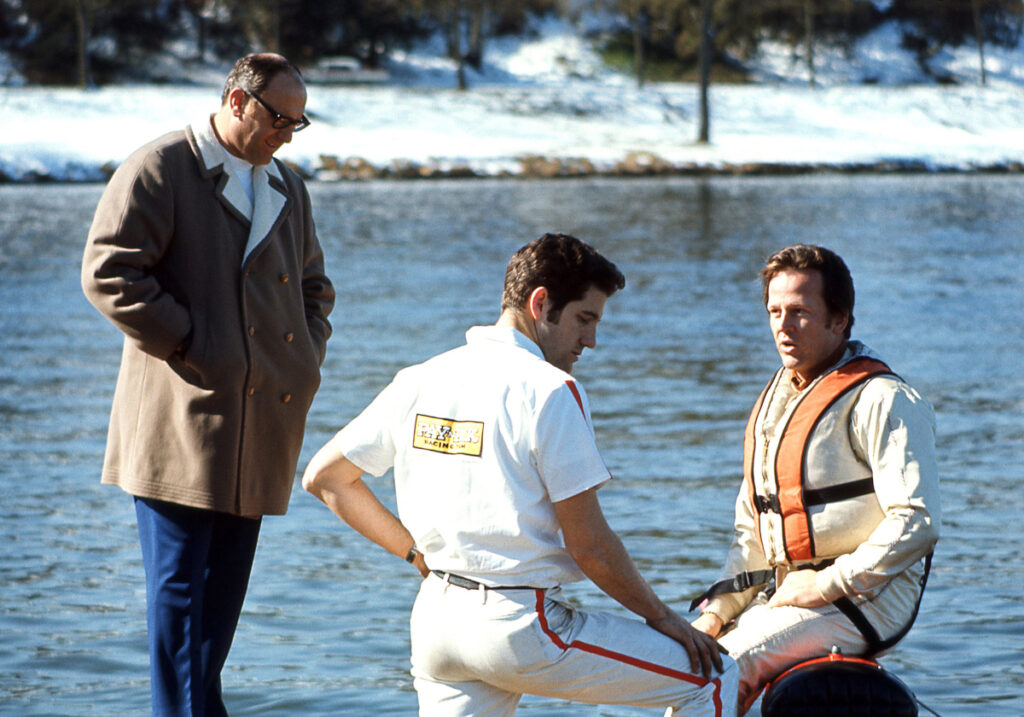
Billy Schumacher (right) with Pride of Pay ‘N Pak owner Dave Heerensperger (left) and crew chief Jim Lucero (center) while testing on a cold day in Seattle in 1971. Photo by Randy Hall
Race in peace, Billy, and thanks for the memories.
Featured Articles
